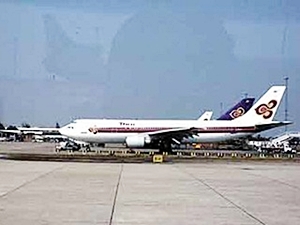BANGKOK, Nov 11 – Thai Airways, Thailand’s national flag carrier, has cut its one-way ticket prices from Bangkok to five southern destinations as flooding in the capital threatens the only highway from the capital to the South.
Piyasavasti Amranand, airline president, said Prime Minister Yingluck Shinawatra is concerned about possible flooding on Rama II Road, the last main route from the capital to the southern provinces after two other routes, Phetchakasem Road and Boromarajonani Road have been flooded.

As a result, he said Thai Airways decided to cut ticket prices by 47-58 per cent from Bangkok to southern destinations, with special price ticket available from Nov 11-Dec 10.
The new price for one-way Bangkok-Surat Thani tickets dropped from Bt4,290 to Bt1,820; Krabi from Bt4,490 to Bt1,920; Phuket from Bt4,675 to Bt2,015, Hat Yai from Bt5,155 to Bt2,255; and Samui from Bt6,360 to Bt2,930, all excluding airport tax.
THAI can provide 5,039 seats per day to the five destinations. It can also increase capacity by changing to larger aircraft or increasing flight frequency to accommodate more passengers or to transport more cargo, Mr Piyasavasti said.
Meanwhile, the flood situation in Bangkok’s Bang Khun Thian seaside district threatens Rama II Road, the main remaining route to the South. Floodwaters have started to overflow onto Bang Khun Thian- Bang Bon Road, 500 metres from Rama II.
Pongsak Phansawat, Bang Khun Thian district chief, said the flood on the Bang Khun Thian-Bang Bon Road overflowed from backed up drains. If the flood hits Rama II Road, the district will drain floodwater into the sea as soon as possible.
In Soi Bangkhuntien 14, about 40cm deep floodwater began turning foul, affecting the areas naturally-fed shrimp farms. Many canned-food factories are still operating with sand bag barriers piled up around their premises.
Shrimp farmers were warned by Bang Khun Thian district to catch shrimp for sale before their farms are flooded. However, many farmers argued that their shrimp size was too small and they could not be sold.




